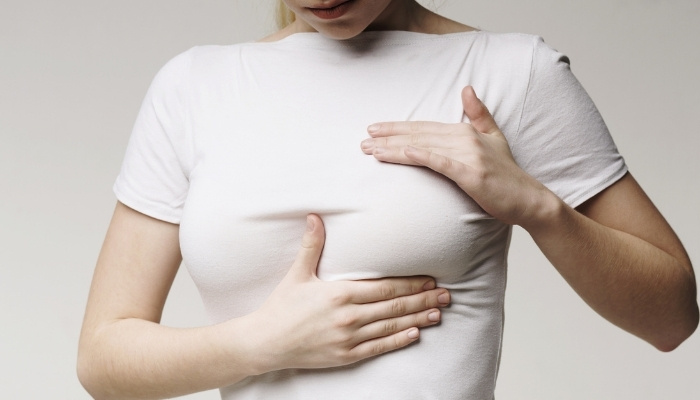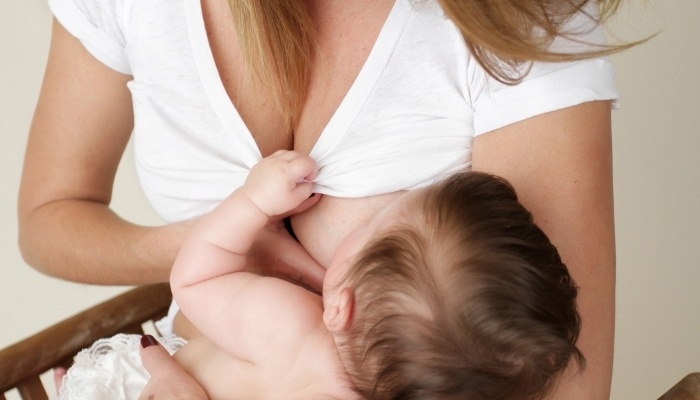The weight of breasts when breastfeeding is approximately 35% greater than the weight of non-breastfeeding breasts of the same size.
The exact weight depends on your breast milk capacity, which is how much milk your breasts can hold, but the increased blood volume circulating in the tissues adds weight as well.
You can estimate the weight of your breasts through the water displacement method or your cup size.
Medical News Today explains what you can expect:
“Typically, the breasts remain enlarged for at least the first few months of nursing.
They tend to feel softer and emptier immediately after feedings and may shrink slightly after the baby starts eating solids.
In general, the breasts remain enlarged until breastfeeding is over.”
Table of Contents
Breast Weight While Breastfeeding
While breastfeeding, you can expect your breasts to get heavier due to milk being constantly produced and the increased volume of other fluids, such as blood and lymphatic fluid.
Nursing my twin boys certainly caused some changes in my breast weight and size, but after the first few months, that initial feeling of extreme heaviness decreased, though they definitely remained larger and fuller than normal.
How Much Breasts Weigh While Breastfeeding
Breastfeeding breasts are about 35% heavier than non-breastfeeding breasts of the same size.
The exact weight depends on your breast milk capacity.
If your breasts can hold six ounces of milk each, they’ll be about six ounces heavier than breasts without milk.
The increase in circulating blood volume in the area and the presence of lymphatic fluid also account for added weight.
How Much Bigger Breasts Get When Breastfeeding
When breastfeeding, breasts increase about two to three times their size.
Even though you’ll most likely notice the change during breastfeeding, breasts actually start changing in early pregnancy when the body starts producing the hormone prolactin.
How To Estimate the Weight of Your Breasts
You can estimate your breasts’ weight through the water displacement method.
- Take a waterproof tray and a large bowl.
- Weigh the tray before putting the bowl on it.
- Fill the bowl with warm water all the way to the brim.
- Put the bowl on a tray.
- Fully submerge your breast in the bowl, displacing some of the water onto the tray. Make sure all the water stays on the tray, and remove the bowl.
- Measure the weight of the tray with water on it.
- Subtract the weight of the empty tray from the weight of the tray with water on it.
- Convert the weight to a more accurate number by multiplying it by 0.9.

You could also use your current cup size to roughly estimate the weight of your breasts.
Remember that this will only give an approximation of weight as band size, tissue density, and other factors influence weight as well.
| Cup Size | Average Weight (per breast) |
|---|---|
| A | 0.25 – 0.5 pounds |
| B | 0.5 – 1 pounds |
| C | 1 – 1.5 pounds |
| D | 1.5 – 2 pounds |
| DD/E | 2 – 2.5 pounds |
| DDD/F | 2.5 – 3 pounds |
| G | 3 – 3.5 pounds |
| H | 3.5 – 4 pounds |
| I | 4 – 4.5 pounds |
| J | 4.5 – 5 pounds |
When To Expect Your Breasts To Return to Normal
It can take several months for your breasts to recover from breastfeeding, and they might look different than they did prior to pregnancy.
Stretch marks, looser skin, and changes in breast size, shape, firmness, and elasticity are common.
Some women may experience minimal changes while others may notice more significant alterations.
The length of time a woman breastfeeds can impact how breasts recover.
Prolonged breastfeeding may lead to more pronounced changes in breast tissue.
Genetic factors also play a role in determining how breasts respond to hormonal changes.
If your mother or sisters experienced certain post-breastfeeding changes, you might see similar changes.
Also, younger skin tends to have more elasticity, which may contribute to a faster recovery.
Significant fluctuations in weight during and after pregnancy can affect the skin’s elasticity and contribute to changes in breast appearance.
Keeping Your Larger Breast Size After Breastfeeding
After breastfeeding, it’s common for breasts to decrease in size.
This is due to various factors, including the reduction of milk production, hormonal fluctuations, and changes in breast tissue.
Your breasts might go back to your original size but differ in shape, elasticity, and firmness, or you might find that you need a different bra size entirely.
However, the odds of maintaining those large, full breasts once you stop breastfeeding are very slim.
Why You Might Not Be Losing Weight as Quickly as Expected
It’s crucial for breastfeeding mothers to focus on maintaining a healthy, balanced diet, staying hydrated, and gradually incorporating physical activity when it’s safe to do so.
Rather than setting unrealistic weight loss goals, the emphasis should be on overall well-being and ensuring an adequate milk supply for the baby.
However, several factors can contribute to a breastfeeding mother not losing weight as quickly as she may have hoped:
- Caloric Intake: It’s essential to strike a balance between meeting the nutritional needs of breastfeeding and creating a modest calorie deficit for weight loss.
- Hormonal Changes: Hormones play a role in lactation and can affect the rate of weight loss. Prolactin, in particular, can stimulate appetite and water retention, which may contribute to slower weight loss.
- Fluid Retention: Retaining fluids is a normal part of the postpartum period, and they should gradually decrease over time.
- Sleep Deprivation: Lack of sleep can impact metabolism and increase cravings for high-calorie foods. Sleep deprivation can also affect the body’s ability to regulate hunger and fullness signals.
- Postpartum Healing: The body undergoes significant changes during pregnancy and childbirth. You may need more time for your body to recover before engaging in intense physical activity.
- Genetic Factors: Individual variations in metabolism and genetic factors can influence how quickly someone loses weight.

Common Questions About Breastfeeding Breasts
How Much Breast Milk Can a Breast Hold?
The amount of breast milk a breast can hold depends on a mother’s breast milk capacity.
This number differs from woman to woman, and it can be anywhere between 2.5 and 20.5 ounces.
The amount of breast milk a breast can hold affects how many times a woman feeds her baby each day.
How Long Does a Breast Take To Refill?
A breast takes about 20 to 30 minutes to refill enough to feed your baby but an hour to get the most milk flow.
A breastfeeding breast is never fully empty, but during a feeding, your breasts lose milk.
The more you empty your breast, the quicker your body makes milk.
Does Breastfeeding Make Your Breasts Sag?
No, breastfeeding doesn’t make your breasts sag. Pregnancy makes your breasts sag.
During pregnancy, the ligaments in your chest stretch to compensate for your growing breasts.
Even if a woman chooses not to breastfeed, her breasts may sag because of the stretching ligaments.
When Will Breasts Go Back to Normal After Breastfeeding?
After breastfeeding, your breasts probably won’t go back to what they were before pregnancy.
Your breasts will be in their new normal size around three months after weaning.
Due to the change in size and texture, you may also notice them looking more lopsided.
Do Nipples Go Back to Normal After Breastfeeding?
Yes, nipples go back to normal after breastfeeding. During pregnancy, some women’s nipples get darker due to hormonal changes.
While some women experience a permanent change in their nipple color, most go back to their pre-pregnancy state after weaning.
How Much Does Breast Size Affect Weight?
When comparing breastfeeding to non-breastfeeding breasts, breastfeeding ones weigh about 35% more than non-breastfeeding ones of the same size.
Bigger breasts, of course, weigh more than smaller ones.
Mom of three (including identical twin boys), wife, and owner of Parents Wonder. This is my place to share my journey as a mother and the helpful insights I learn along the way.

